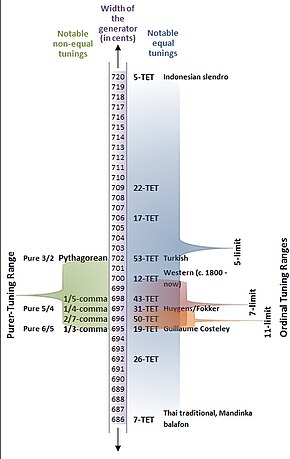17 equal temperament
 From Wikipedia the free encyclopedia
From Wikipedia the free encyclopedia

In music, 17 equal temperament is the tempered scale derived by dividing the octave into 17 equal steps (equal frequency ratios). Each step represents a frequency ratio of 17√2, or 70.6 cents.
17-ET is the tuning of the regular diatonic tuning in which the tempered perfect fifth is equal to 705.88 cents, as shown in Figure 1 (look for the label "17-TET").
History and use
[edit]Alexander J. Ellis refers to a tuning of seventeen tones based on perfect fourths and fifths as the Arabic scale.[2] In the thirteenth century, Middle-Eastern musician Safi al-Din Urmawi developed a theoretical system of seventeen tones to describe Arabic and Persian music, although the tones were not equally spaced. This 17-tone system remained the primary theoretical system until the development of the quarter tone scale.[citation needed]
Notation
[edit]
Easley Blackwood Jr. created a notation system where sharps and flats raised/lowered 2 steps. This yields the chromatic scale:
- C, D♭, C♯, D, E♭, D♯, E, F, G♭, F♯, G, A♭, G♯, A, B♭, A♯, B, C
Quarter tone sharps and flats can also be used, yielding the following chromatic scale:
Interval size
[edit]Below are some intervals in 17-EDO compared to just.

| 17-et | |
| just | |
| 12-et |

| interval name | size (steps) | size (cents) | midi | just ratio | just (cents) | midi | error |
|---|---|---|---|---|---|---|---|
| octave | 17 | 1200 | 2:1 | 1200 | 0 | ||
| minor seventh | 14 | 988.23 | 16:9 | 996 | −7.77 | ||
| perfect fifth | 10 | 705.88 | 3:2 | 701.96 | +3.93 | ||
| septimal tritone | 8 | 564.71 | 7:5 | 582.51 | −17.81 | ||
| tridecimal narrow tritone | 8 | 564.71 | 18:13 | 563.38 | +1.32 | ||
| undecimal super-fourth | 8 | 564.71 | 11:8 | 551.32 | +13.39 | ||
| perfect fourth | 7 | 494.12 | 4:3 | 498.04 | −3.93 | ||
| septimal major third | 6 | 423.53 | 9:7 | 435.08 | −11.55 | ||
| undecimal major third | 6 | 423.53 | 14:11 | 417.51 | +6.02 | ||
| major third | 5 | 352.94 | 5:4 | 386.31 | −33.37 | ||
| tridecimal neutral third | 5 | 352.94 | 16:13 | 359.47 | −6.53 | ||
| undecimal neutral third | 5 | 352.94 | 11:9 | 347.41 | +5.53 | ||
| minor third | 4 | 282.35 | 6:5 | 315.64 | −33.29 | ||
| tridecimal minor third | 4 | 282.35 | 13:11 | 289.21 | −6.86 | ||
| septimal minor third | 4 | 282.35 | 7:6 | 266.87 | +15.48 | ||
| septimal whole tone | 3 | 211.76 | 8:7 | 231.17 | −19.41 | ||
| whole tone | 3 | 211.76 | 9:8 | 203.91 | +7.85 | ||
| neutral second, lesser undecimal | 2 | 141.18 | 12:11 | 150.64 | −9.46 | ||
| greater tridecimal 2⁄3-tone | 2 | 141.18 | 13:12 | 138.57 | +2.60 | ||
| lesser tridecimal 2⁄3-tone | 2 | 141.18 | 14:13 | 128.30 | +12.88 | ||
| septimal diatonic semitone | 2 | 141.18 | 15:14 | 119.44 | +21.73 | ||
| diatonic semitone | 2 | 141.18 | 16:15 | 111.73 | +29.45 | ||
| septimal chromatic semitone | 1 | 70.59 | 21:20 | 84.47 | −13.88 | ||
| chromatic semitone | 1 | 70.59 | 25:24 | 70.67 | −0.08 |
Relation to 34-ET
[edit]17-ET is where every other step in the 34-ET scale is included, and the others are not accessible. Conversely 34-ET is a subdivision of 17-ET.
References
[edit]- ^ Milne, Sethares & Plamondon 2007, pp. 15–32.
- ^ Ellis, Alexander J. (1863). "On the Temperament of Musical Instruments with Fixed Tones", Proceedings of the Royal Society of London, vol. 13. (1863–1864), pp. 404–422.
- ^ Blackwood, Easley (Summer 1991). "Modes and Chord Progressions in Equal Tunings". Perspectives of New Music. 29 (2): 166–200 (175). doi:10.2307/833437. JSTOR 833437.
- ^ Milne, Sethares & Plamondon 2007, p. 29.
Sources
- Milne, Andrew; Sethares, William; Plamondon, James (Winter 2007). "Isomorphic Controllers and Dynamic Tuning: Invariant Fingering over a Tuning Continuum". Computer Music Journal. 31 (4): 15–32. doi:10.1162/comj.2007.31.4.15. S2CID 27906745.
External links
[edit]- "The 17-tone Puzzle — And the Neo-medieval Key that Unlocks It" by George Secor
- Libro y Programa Tonalismo, heptadecatonic system applications (in Spanish)
- Georg Hajdu's 1992 ICMC paper on the 17-tone piano project
- "Crocus", 17 equal temperament, 9 tone mode on YouTube, by Wongi Hwang
